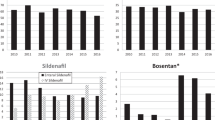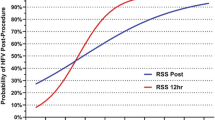Abstract
Objective
To predict pulmonary hypertension (PH) therapy at discharge in a large multicenter cohort of infants with congenital diaphragmatic hernia (CDH).
Study design
Six-year linked records from Children’s Hospitals Neonatal Database and Pediatric Health Information System were used; patients whose diaphragmatic hernia was repaired before admission or referral, who were previously home before admission or referral, and non-survivors were excluded. The primary outcome was the use of PH medications at discharge and the secondary outcome was an inter-center variation of therapies during inpatient utilization. Clinical factors were used to develop a multivariable equation randomly applied to 80% cohort; validated in the remaining 20% infants.
Results
A total of 831 infants with CDH from 23 centers were analyzed. Overall, 11.6% of survivors were discharged on PH medication. Center, duration of mechanical ventilation, and duration of inhaled nitric oxide were associated with the use of PH medication at discharge. This model performed well in the validation cohort area under the receiver operating characteristic curve of 0.9, goodness-of-fit χ2, p = 0.17.
Conclusions
Clinical variables can predict the need for long-term PH medication after NICU hospitalization in surviving infants with CDH. This information may be useful to educate families and guide the development of clinical guidelines.
This is a preview of subscription content, access via your institution
Access options
Subscribe to this journal
Receive 12 print issues and online access
$259.00 per year
only $21.58 per issue
Buy this article
- Purchase on Springer Link
- Instant access to full article PDF
Prices may be subject to local taxes which are calculated during checkout


Similar content being viewed by others
References
Khan AA, Furey EA, Bailey AA, Xi Y, Schindel DT, Santiago-Munoz PC, et al. Fetal liver and lung volume index of neonatal survival with congenital diaphragmatic hernia. Pediatr Radiol. 2021;51:1637–44.
Oluyomi-Obi T, Kuret V, Puligandla P, Lodha A, Lee-Robertson H, Lee K, et al. Antenatal predictors of outcome in prenatally diagnosed congenital diaphragmatic hernia (CDH). J Pediatr Surg. 2017;52:881–8.
Ferguson DM, Gupta VS, Lally PA, Luco M, Tsao K, Lally KP, et al. Early, postnatal pulmonary hypertension severity predicts inpatient outcomes in congenital diaphragmatic hernia. Neonatology. 2021;118:147–54.
Dao DT, Patel N, Harting MT, Lally KP, Lally PA, Buchmiller TL. Early left ventricular dysfunction and severe pulmonary hypertension predict adverse outcomes in “low-risk” congenital diaphragmatic hernia. Pediatr Crit Care Med. 2020;21:637–46.
Kinsella JP, Steinhorn RH, Mullen MP, Hopper RK, Keller RL, Ivy DD, et al. The left ventricle in congenital diaphragmatic hernia: implications for the management of pulmonary hypertension. J Pediatr. 2018;197:17–22.
Seetharamaiah R, Younger JG, Bartlett RH, Hirschl RB. Factors associated with survival in infants with congenital diaphragmatic hernia requiring extracorporeal membrane oxygenation: a report from the Congenital Diaphragmatic Hernia Study Group. J Pediatr Surg. 2009;44:1315–21.
Gupta VS, Harting MT, Lally PA, Miller CC, Hirschl RB, Davis CF, et al. Mortality in congenital diaphragmatic hernia: a multicenter registry study of over 5000 patients over 25 years. Ann Surg. 2021. Online ahead of print.
Murthy K, Pallotto EK, Gien J, Brozanski BS, Porta NF, Zaniletti I, et al. Predicting death or extended length of stay in infants with congenital diaphragmatic hernia. J Perinatol. 2016;36:654–9.
Lally KP, Lasky RE, Lally PA, Bagolan P, Davis CF, Frenckner BP, et al. Standardized reporting for congenital diaphragmatic hernia-an international consensus. J Pediatr Surg. 2013;48:2408–15.
Ali K, Dassios T, Khaliq SA, Williams EE, Tamura K, Davenport M, et al. Outcomes of infants with congenital diaphragmatic hernia by side of defect in the FETO era. Pediatr Surg Int. 2019;35:743–7.
Tracy ET, Mears SE, Smith PB, Danko ME, Diesen DL, Fisher KA, et al. Protocolized approach to the management of congenital diaphragmatic hernia: benefits of reducing variability in care. J Pediatr Surg. 2010;45:1343–8.
Logan JW, Cotten CM, Goldberg RN, Clark RH. Mechanical ventilation strategies in the management of congenital diaphragmatic hernia. Semin Pediatr Surg. 2007;16:115–25.
Antonoff MB, Hustead VA, Groth SS, Schmeling DJ. Protocolized management of infants with congenital diaphragmatic hernia: effect on survival. J Pediatr Surg. 2011;46:39–46.
Kumar VHS, Dadiz R, Koumoundouros J, Guilford S, Lakshminrusimha S. Response to pulmonary vasodilators in infants with congenital diaphragmatic hernia. Pediatr Surg Int. 2018;34:735–42.
Lawrence KM, Monos S, Adams S, Herkert L, Peranteau WH, Munson DA, et al. Inhaled nitric oxide is associated with improved oxygenation in a subpopulation of infants with congenital diaphragmatic hernia and pulmonary hypertension. J Pediatr. 2020;219:167–72.
Kool H, Mous D, Tibboel D, de Klein A, Rottier RJ. Pulmonary vascular development goes awry in congenital lung abnormalities. Birth Defects Res C Embryo Today. 2014;102:343–58.
Montalva L, Antounians L, Zani A. Pulmonary hypertension secondary to congenital diaphragmatic hernia: factors and pathways involved in pulmonary vascular remodeling. Pediatr Res. 2019;85:754–68.
Dillon PW, Cilley RE, Mauger D, Zachary C, Meier A. The relationship of pulmonary artery pressure and survival in congenital diaphragmatic hernia. J Pediatr Surg. 2004;39:307–12.
Lusk LA, Wai KC, Moon-Grady AJ, Steurer MA, Keller RL. Persistence of pulmonary hypertension by echocardiography predicts short-term outcomes in congenital diaphragmatic hernia. J Pediatr. 2015;166:251–6.
Wong M, Reyes J, Lapidus-Krol E, Chiang M, Humpl T, Al-Faraj M, et al. Pulmonary hypertension in congenital diaphragmatic hernia patients: prognostic markers and long-term outcomes. J Pediatr Surg. 2018;53:918–24.
The Neonatal Inhaled Nitric Oxide Study Group (NINOS) Inhaled nitric oxide and hypoxic respiratory failure in infants with congenital diaphragmatic hernia. Pediatrics. 1997;99:838–45.
Putnam LR, Tsao K, Morini F, Lally PA, Miller CC. Evaluation of variability in inhaled nitric oxide use and pulmonary hypertension in patients with congenital diaphragmatic hernia. JAMA Pediatr. 2016;170:1188–94.
Barrington KJ, Finer N, Pennaforte T, Altit G. Nitric oxide for respiratory failure in infants born at or near term. Cochrane Database Syst Rev. 2017;1:CD000399.
Kelly LE, Ohlsson A, Shah PS. Sildenafil for pulmonary hypertension in neonates. Cochrane Database Syst Rev. 2017;8:CD005494.
Carpentier E, Mur S, Aubry E, Pognon L, Rakza T, Flamein F, et al. Safety and tolerability of subcutaneous treprostinil in newborns with congenital diaphragmatic hernia and life-threatening pulmonary hypertension. J Pediatr Surg. 2017;52:1480–3.
Steinhorn RH, Fineman J, Kusic-Pajic A, Cornelisse P, Gehin M, Nowbakht P, et al. Bosentan as adjunctive therapy for persistent pulmonary hypertension of the newborn: results of the randomized multicenter placebo-controlled exploratory trial. J Pediatr. 2016;177:90–6.
Lawrence KM, Berger K, Herkert L, Franciscovich C, O’Dea CLH, Waqar LN, et al. Use of prostaglandin E1 to treat pulmonary hypertension in congenital diaphragmatic hernia. J Pediatr Surg. 2019;54:55–9.
James AT, Corcoran JD, McNamara PJ, Franklin O, El-Khuffash AF. The effect of milrinone on right and left ventricular function when used as a rescue therapy for term infants with pulmonary hypertension. Cardiol Young. 2016;26:90–9.
Seabrook RB, Grover TR, Rintoul N, Weems M, Keene S, Brozanski B, et al. Treatment of pulmonary hypertension during initial hospitalization in a multicenter cohort of infants with congenital diaphragmatic hernia (CDH). J Perinatol. 2021;41:803–13.
Murthy K, Dykes FD, Padula MA, Pallotto EK, Reber KM, Durand DJ, et al. The Children’s Hospitals Neonatal Database: an overview of patient complexity, outcomes, and variation in care. J Perinatol. 2014;34:582–6.
Brindle ME, Cook EF, Tibboel D, Lally PA, Lally KP. A clinical prediction rule for the severity of congenital diaphragmatic hernias in newborns. Pediatrics. 2014;134:e413–9.
Datta J, Phillips SE, Yang EY. Association of high ventilator pressures with the development of chronic pulmonary hypertension in congenital diaphragmatic hernia patients requiring ECMO. Pediatr Surg Int. 2012;28:977–82.
Jancelewicz T, Brindle ME, Guner YS, Lally PA, Lally KP, Harting MT. et al. Toward standardized management of congenital diaphragmatic hernia: an analysis of practice guidelines. J Surg Res. 2019;243:229–35.
van den Hout L, Schaible T, Cohen-Overbeek TE, Hop W, Siemer J, van de Ven K, et al. Actual outcome in infants with congenital diaphragmatic hernia: the role of a standardized postnatal treatment protocol. Fetal Diagn Ther. 2011;29:55–63.
Apfeld JC, Kastenberg ZJ, Gibbons AT, Carmichael SL, Lee HC, Sylvester KG. Treating center volume and congenital diaphragmatic hernia outcomes in California. J Pediatr. 2020;222:146–53.e1.
Harting MT, Hollinger L, Tsao K, Putnam LR, Wilson JM, Hirschl RB, et al. Aggressive surgical management of congenital diaphragmatic hernia: worth the effort?: A multicenter, prospective, cohort study. Ann Surg. 2018;267:977–82.
Acknowledgements
Jeanette Asselin, Beverly Brozanski, David Durand (ex officio), Francine Dykes (ex officio), Jacquelyn Evans (Executive Director), Theresa Grover, Karna Murthy (Chair), Michael Padula, Eugenia Pallotto, Anthony Piazza, Kristina Reber, and Billie Short are members of the Children’s Hospitals Neonatal Consortium, Inc. For more information, please contact: support@thechnc.org.
Author information
Authors and Affiliations
Consortia
Contributions
All authors and members of the Children’s Hospitals Neonatal Consortium Congenital Diaphragmatic Hernia Focus Group conceptualized the study, were responsible for the study design; collection, analysis, and interpretation of the data; and decision to submit the manuscript for publication. BM drafted the initial manuscript, reviewed, and revised the final manuscript. KM, NR, MW, SK, BB, RD, BH, HH, JG, RS, NA, RC, JD, AH, YJ, NFMP, MU, IZ, and TRG critically reviewed and revised the manuscript for important intellectual content. All authors approved the final manuscript as submitted and agree to be accountable for all aspects of the work.
Corresponding author
Ethics declarations
Competing interests
BB, TRG, and KM are board members of the Children’s Hospitals Neonatal Consortium, 501(c)(3) non-profit organization that manages and owns the Children’s Hospitals Neonatal Database, a data source used in this study. None of the remaining authors have any financial or other conflicts of interest as described in the author’s instructions. There were no study sponsors involved in the creation of the manuscript.
Additional information
Publisher’s note Springer Nature remains neutral with regard to jurisdictional claims in published maps and institutional affiliations.
Rights and permissions
About this article
Cite this article
Mahmood, B., Murthy, K., Rintoul, N. et al. Predicting treatment of pulmonary hypertension at discharge in infants with congenital diaphragmatic hernia. J Perinatol 42, 45–52 (2022). https://doi.org/10.1038/s41372-021-01249-6
Received:
Revised:
Accepted:
Published:
Issue Date:
DOI: https://doi.org/10.1038/s41372-021-01249-6



